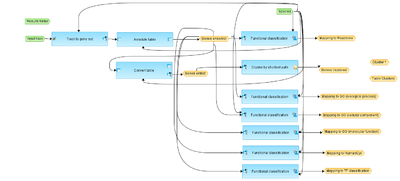ChIP-Seq - Identify and classify target genes (workflow)
- Workflow title
- ChIP-Seq - Identify and classify target genes
- Provider
- geneXplain GmbH
Workflow overview
Description
This workflow identifies and classifies target genes using positional information of peaks found by a ChiP-Seq experiment. The peak regions in BED format can be submitted as input.
Actually, any dataset in BED format can be submitted as input track for this workflow.
First, the track file is converted into a gene set using Track to gene set analysis. The Ensembl gene list is then annotated with additional information, gene descriptions and chromosomal location.
The annotated Ensembl genes are submitted to Functional classification method, using the following ontologies: GO biological processes, GO cellular components, GO molecular function, Transcription Factor classification, Reactome and HumanCyc pathways.
In parallel with the Functional classification, the Ensembl gene list is used for a clustering analysis (Cluster by shortest path) to find gen clusters with a maximum search radius of 2. The searching steps were done in both directions, upstream and downstream, from the input gene list. The clustering is performed using the GeneWays database.
The output folder contains the mapped classification results, a list of annotated Ensembl genes and a diagram of the clustered GeneWays genes.
Parameters
- Input track
- Species
- Results folder
